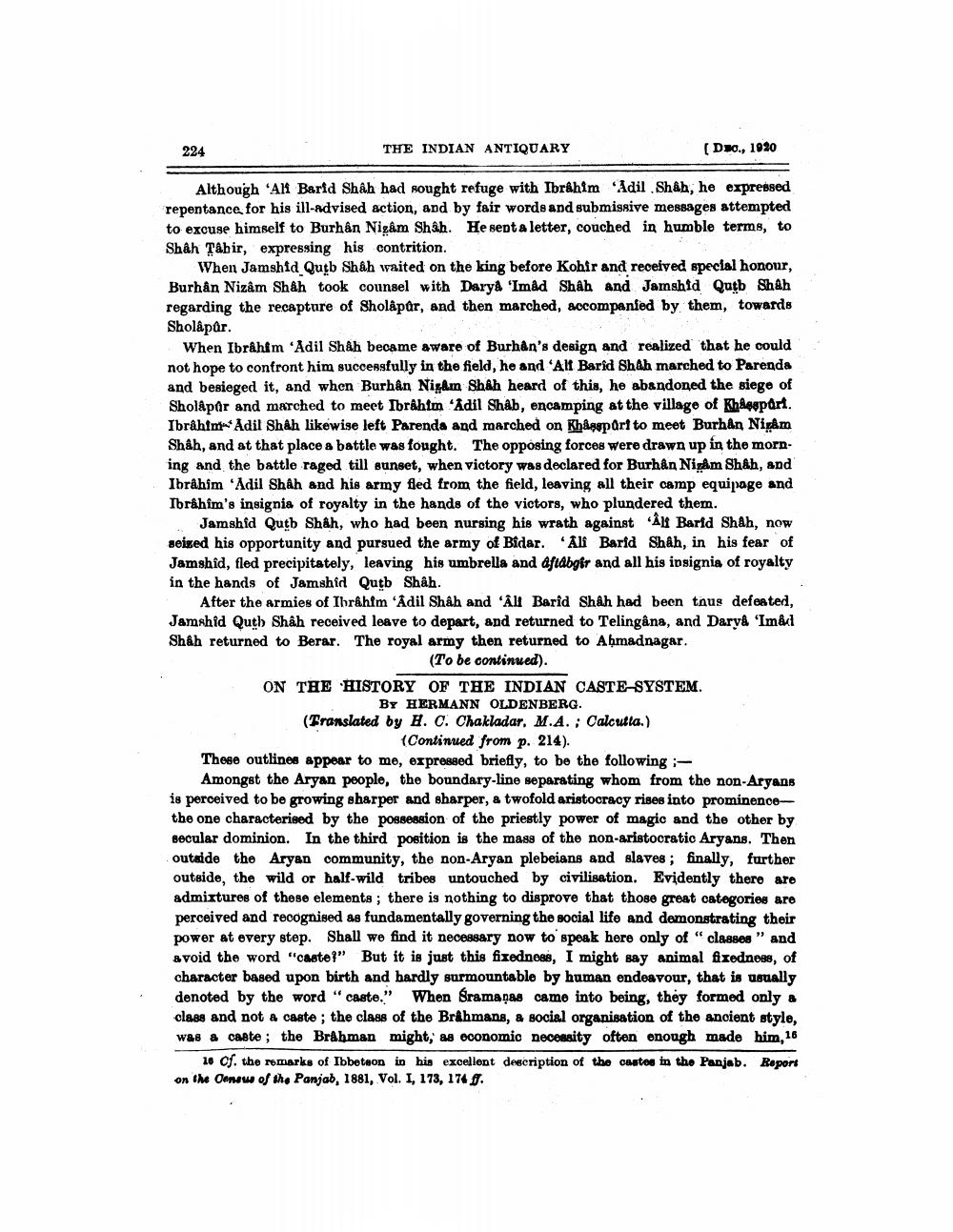________________
224
THE INDIAN ANTIQUARY
(Dwo., 1920
Although 'All Barid Shah had sought refuge with Ibrahim Adil Shah, he expressed repentance for his ill-advised action, and by fair words and submissive messages attempted to excuse himself to Burhan Nigam Shah. He sept a letter, couched in humble terms, to Shah Tahir, expressing his contrition.
When Jamshid Qutb Shah waited on the king before Kohir and received special honour, Burhan Nizam Shah took counsel with Darya 'Imad Shah and Jamshid Qutb Shah regarding the recapture of Sholapar, and then marched, accompanied by them, towards Sholapur.
When Ibrahim Adil ShAh became aware of Burhan's design and realized that he could not hope to confront him successfully in the field, he and 'Alt Barid Shah marched to Parenda and besieged it, and when Burhan Nigam Shah heard of this, he abandoned the siege of Sholậpor and marched to meet Ibrahim "Adil Shab, encamping at the village of Khlosport. Ibråhim-Adil Shah likewise left Parenda and marched on Khånsport to meet Burhan Nigam Shah, and at that place a battle was fought. The opposing forces were drawn up in the morning and the battle raged till sunset, when victory was declared for Burhan Nizam Shah, and Ibrahim 'Adil Shah and his army fled from the field, leaving all their camp equipage and Ibråhim's insignia of royalty in the hands of the victors, who plundered them.
Jamshid Qutb Shah, who had been nursing his wrath against All Barid Shah, now seized his opportunity and purgued the army of Bidar. 'Ali Barid Shah, in his fear of Jamshid, fled precipitately, leaving his umbrella and aftabgir and all his insignia of royalty in the hands of Jamshid Qutb Shâh.
After the armies of Ibrahim 'Adil Shah and 'Alt Barid Shah had been taus defeated, Jamshid Quth Shâh received leave to depart, and returned to Telingana, and Darya 'Ima Shâh returned to Berar. The royal army then returned to Ahmadnagar.
(To be continued). ON THE HISTORY OF THE INDIAN CASTE-SYSTEM.
BY HERMANN OLDENBERG. (Translated by H. C. Chakladar, M.A.; Calcutta.)
(Continued from p. 214). These outlines appear to me, expressed briefly, to be the following: -
Amongst the Aryan people, the boundary-line separating whom from the non-Aryans is perceived to be growing sharper and sharper, a twofold aristocracy rises into prominence the one characterised by the possession of the priestly power of magic and the other by secular dominion. In the third position is the mass of the non-aristocratic Aryans. Then outside the Aryan community, the non-Aryan plebeians and slaves; finally, further outside, the wild or half-wild tribes untouched by civilisation. Evidently there are admixtures of these elements; there is nothing to disprove that those great categories are perceived and recognised as fundamentally governing the social life and demonstrating their power at every step. Shall we find it necessary now to speak here only of " classes " and avoid the word "caste!" But it is just this fixedness, I might say animal fixedness, of character based upon birth and hardly surmountable by human endeavour, that is usually denoted by the word "caste." When Bramaņas came into being, they formed only a class and not a caste; the class of the Brahmans, & social organisation of the ancient style, was a caste; the Brahman might, as economic necessity often enough made him, 16
16 of the remarks of Ibbetson in his excellent description of the castes in the Panjab. Report on the Oenew of the Panjab, 1881, Vol. I, 173, 174 f.




